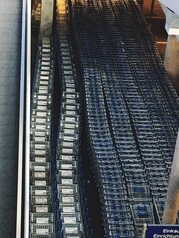The influence of the work environment on property value.

The location of a property is a key factor that impacts its appreciation, but what about the work environment? This element, often overlooked, can be decisive in the value of real estate. In this article, we will explore how proximity to offices, factories, and shopping centers not only improves the quality of life for residents but can also significantly increase the value of your property. Discover how the work environment transforms neighborhoods and communities into desirable places to live and invest.
1. The connection between employment and real estate demand
The relationship between employment and real estate demand is fundamental to understanding how the real estate market is shaped. When an area has a high concentration of businesses, offices, and shopping centers, a constant flow of workers seeking nearby residences is generated. This not only increases the demand for properties in those areas but also raises prices, as buyers are willing to pay more for the convenience of avoiding long commutes. Additionally, the presence of stable and well-paying jobs in the region attracts new residents looking to improve their quality of life, which also contributes to the increase in property value.
Likewise, local economic development is often accompanied by improvements in infrastructure and public services, which makes the location even more attractive to potential buyers. Neighborhoods close to workplaces tend to receive investments in public transport, education, and health, creating a favorable living environment. This growth can turn into a virtuous circle: as the demand for housing increases due to job creation, local authorities often invest more in the area, further enhancing its appeal. Thus, the work environment not only directly influences real estate prices but also acts as a catalyst for the comprehensive development of entire communities.
2. Strategic areas: where economic activity is concentrated
The concentration of economic activity in strategic areas is a crucial factor that directly influences the added value of properties. Locations near corporate offices, factories, and shopping centers tend to experience an increase in the flow of people, which not only energizes the local economy but also raises housing demand. By living close to these work areas, residents enjoy greater convenience and accessibility, reducing their commuting time and enhancing their quality of life. This appeal translates into an increase in real estate value in these areas, as more buyers are willing to invest there.
Additionally, companies often seek to establish themselves in areas with high potential for demographic and economic growth. This creates a positive cycle: as more businesses settle in a region, more jobs are generated, leading to a greater need for housing. Communities that manage to attract significant investments quickly become focal points of interest for developers and real estate investors. Therefore, understanding how economic activity concentrates in certain areas allows property owners and investors to anticipate trends and make informed decisions about their properties. Ultimately, this synergy between the labor environment and the real estate market highlights the importance of considering economic factors when evaluating the appreciation of any property.
3. Impact of remote work on property valuation
Telecommuting has transformed the work dynamic and, with it, the valuation of properties in urban areas. Before this trend, properties close to offices and workplaces tended to have a higher value due to the constant demand generated by employees seeking to minimize their commuting time. However, with the rise of telecommuting, many people have started to prioritize other aspects in their housing search, such as personal space and home amenities. This revaluation of criteria has led to a reassessment of property values; those properties located in less central areas but with better residential features are gaining ground in the market.
Labor flexibility is also promoting a shift towards more suburban or rural communities, where the cost of living can be more attractive. This phenomenon not only affects the immediate price of properties in these areas but can also influence urban planning and local infrastructure. By attracting professionals seeking a balance between work and quality of life, these areas may experience a significant increase in their property value as new commercial facilities and public services are developed to meet the emerging needs of their new residents. Consequently, understanding how remote work impacts real estate valuation is essential for those looking to invest wisely in real estate.
4. Labor infrastructure: an attraction for buyers
The labor infrastructure of an area, which includes the presence of companies, offices, and shopping centers, not only provides job opportunities for residents but also enhances the quality of life in the community. Proximity to these facilities can facilitate access to jobs and reduce commuting times, which is a highly valued aspect by potential buyers. Thus, areas with strong labor infrastructure often experience an increase in property demand, resulting in a significant rise in their value.
Additionally, a good work infrastructure attracts professionals and families seeking a dynamic environment where they can blend work and personal life. Communities with recognized businesses or thriving shopping centers tend to develop complementary services such as restaurants, gyms, and parks, thereby creating a vibrant and attractive atmosphere. This multiplier effect not only benefits those residing in the area but also makes these neighborhoods desirable destinations for real estate investors. Consequently, the appreciation of properties in these areas is driven by their ability to offer a comprehensive experience to their inhabitants.
5. Effects of labor policies on the real estate market
Labor policies have a direct impact on the real estate market by influencing the economic stability of a region. When a government implements measures that promote employment, such as tax incentives for companies or job training programs, it creates a favorable environment for growth and the attraction of new investments. This, in turn, drives the demand for housing in areas close to these workplaces. The creation of well-paying jobs not only elevates the quality of life for residents but also increases competition for properties in the vicinity, which can result in a significant increase in property value.
Additionally, policies that promote telecommuting or hybrid models can transform the way a property is valued. As more people choose to work from home, the demand for homes with suitable office spaces has increased, thus altering market expectations. Areas that were previously considered peripheral are starting to gain appeal if they offer good digital connections and proximity to essential services. This shift not only directly affects property prices but also redefines what features are valued by buyers and renters in the current environment.
6. Success stories: neighborhoods that have grown due to their work environment
One of the most emblematic cases is that of the Santa Fe area in Mexico City. This neighborhood, which for years was considered an underdeveloped area, has experienced a remarkable boom thanks to the arrival of multinational companies and corporate offices. The creation of modern business complexes not only attracted thousands of professionals seeking employment but also spurred the construction of housing and complementary services such as restaurants, schools, and shopping centers. As a result, property prices have increased significantly, turning Santa Fe into one of the most sought-after places to live and invest in the Mexican capital.
Another illustrative example is the case of the tech neighborhood of Silicon Valley in California. This area has seen exponential growth due to its highly specialized work environment, where some of the most innovative companies in the world are concentrated. The constant demand for housing has led to the massive development of new residential and commercial projects. As more employees move to the area in search of job opportunities, land and property values have reached record figures. This transformation not only benefits existing owners but also creates a vibrant ecosystem with a superior quality of life for all its inhabitants, thereby reinforcing the link between the work environment and real estate appreciation.
7. Tips for investors: how to assess the potential for appreciation related to employment
The assessment of the potential for added value related to employment requires a thorough analysis of several factors that directly impact the value of a property. First, it is crucial to investigate the proximity to important job centers and their stability. The presence of large companies or industries in the neighborhood not only promises stable jobs but also attracts more residents seeking convenience and accessibility. Analyzing local labor market trends can provide insights into future expansions or contractions that affect housing demand and, consequently, added value.
Another aspect to consider is the infrastructure and services available in the surrounding area. A thriving working environment is often accompanied by developments in public transportation, businesses, and community services. This not only improves the quality of life for current residents but also makes the area more attractive to future buyers and renters. Investing time in researching urban planning and development projects can provide valuable insights into how the working environment will transform and its long-term impact on real estate value.



